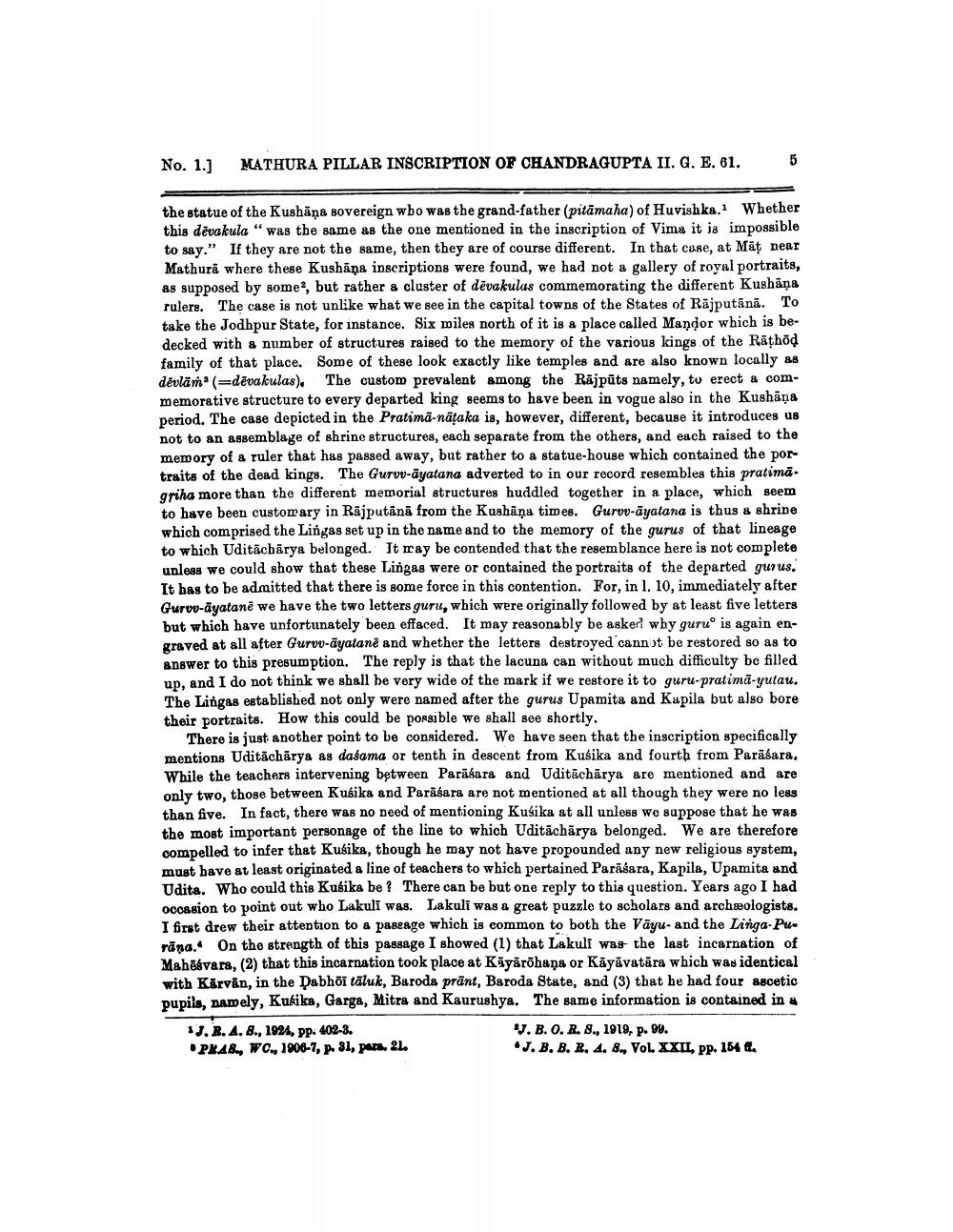________________
No. 1.]
MATHURA PILLAR INSCRIPTION OF CHANDRAGUPTA II. G. E. 61.
the statue of the Kushāņa sovereign wbo was the grand father (pitāmaha) of Huvishka. Whether this dēvakula "was the same as the one mentioned in the inscription of Vima it is impossible to say." If they are not the same, then they are of course different. In that case, at Māt near Mathura where these Kushāna inscriptions were found, we had not a gallery of royal portraits, as supposed by some, but rather a cluster of dēvakulas commemorating the different Kushāņa rulers. The case is not unlike what we see in the capital towns of the States of Rājputānā. To take the Jodhpur State, for instance. Six miles north of it is a place called Mandor which is bedecked with a number of structures raised to the memory of the various kings of the Rāthod family of that place. Some of these look exactly like temples and are also known locally as devlāṁ (=dēvakulas). The custom prevalent among the Rajpūts namely, to erect & commemorative structure to every departed king seems to have been in vogue also in the Kushāņa period. The case depicted in the Pratima-nātaka is, however, different, because it introduces us not to an assemblage of shrine structures, each separate from the others, and each raised to the memory of a ruler that has passed away, but rather to a statue-house which contained the portraits of the dead kings. The Guruv-āyatana adverted to in our record resembles this pratima. griha more than the different memorial structures huddled together in a place, which seem to have been customary in Rajputānā from the Kushāņa times. Guruv-āyatana is thus & shrine which comprised the Lingas set up in the name and to the memory of the gurus of that lineage to which Uditācbarya belonged. It may be contended that the resemblance here is not complete unless we could show that these Linges were or contained the portraits of the departed gurus. It has to be admitted that there is some force in this contention. For, in l. 10, immediately after Guruv-ayatanë we have the two letters guru, which were originally followed by at least five letters but which have unfortunately been effaced. It may reasonably be asked why guruo is again engraved at all after Gurvv-ayatane and whether the letters destroyed cannot be restored so as to answer to this presumption. The reply is that the lacuna can without much difficulty be filled up, and I do not think we shall be very wide of the mark if we restore it to guru-pratima-yutau. The Lingas established not only were named after the gurus Upamita and Kapila but also bore their portraits. How this could be possible we shall see shortly.
There is just another point to be considered. We have seen that the inscription specifically mentions Uditāchārya as dasama or tenth in descent from Kusika and fourth from Parāśara, While the teachers intervening between Parāśara and Uditāchārya are mentioned and are only two, those between Kusika and Parāśara are not mentioned at all though they were no less than five. In fact, there was no need of mentioning Kusika at all unless we suppose that he was the most important personage of the line to which Uditāchārya belonged. We are therefore compelled to infer that Kusika, though he may not have propounded any new religious system, must have at least originated a line of teachers to which pertained Parāśara, Kapila, Upamita and Udita. Who could this Kusika be? There can be but one reply to this question. Years ago I had occasion to point out who Lakuli was. Lakuli was a great puzzle to scholars and archeologists. I first drew their attention to a paseage which is common to both the Väyu- and the Linga-Purāna. On the strength of this passage I showed (1) that Lakull was the last incarnation of Mahēsvara, (2) that this incarnation took place at Kiyarohana or Kāyāvatāra which was identical with Kårvan, in the Dabhoi tāluk, Baroda prānt, Baroda State, and (3) that he had four ascetic pupils, namely, Kukika, Garga, Mitra and Kaurushya. The same information is contained in a 13. B. A. 8., 1924, PP. 402-3.
Y.B.O.R. 8., 1919, p. 99. PRA8., WC., 1906-7, p. 31, poz. 21.
*J. B. B. B. 4. 8., Vol. XXII, pp. 154.




